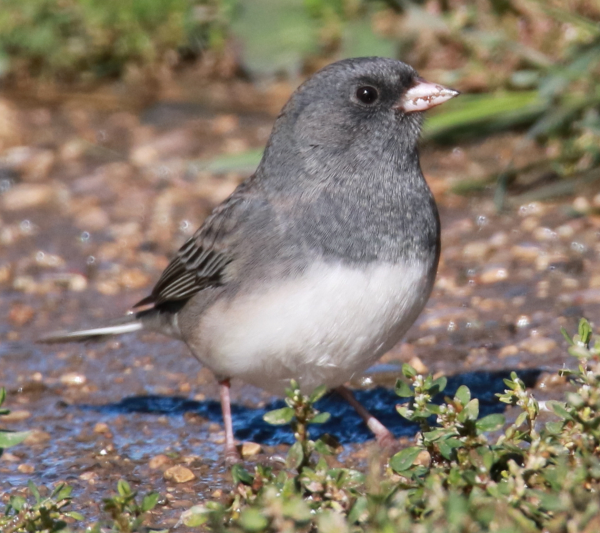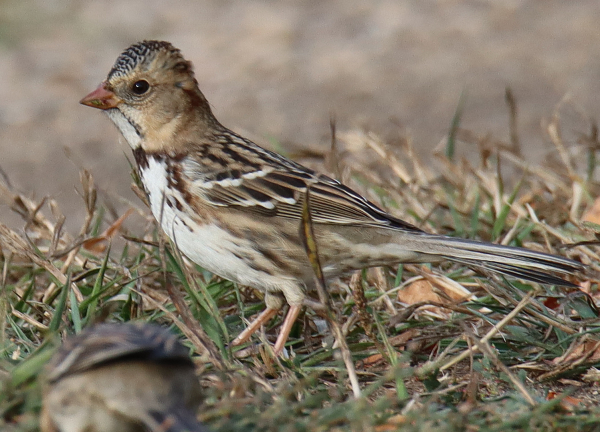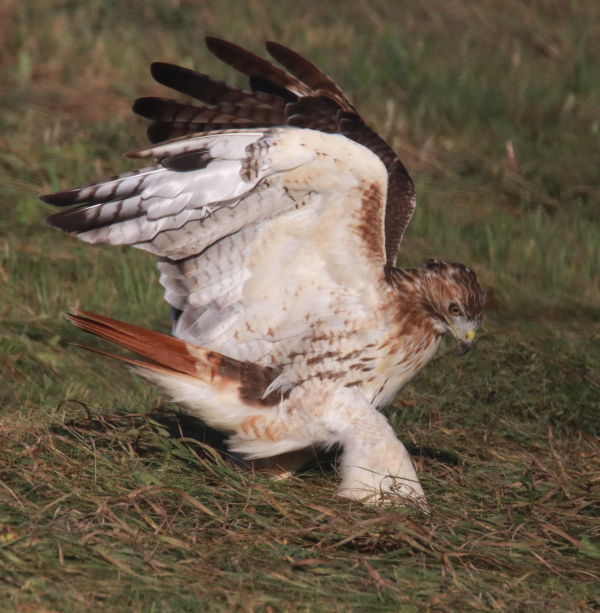
Although sightings of Dark-eyed Juncos are still pretty rare, they were the most common migrants last week, and they are always enjoyable to observe.

Harris’s Sparrows are special to the Central Flyway, and they stand out with their larger size, distinctive black and white plumage on their neck and breast, their longer tail, and pinkish beak.

The moment of impact was recorded in this photograph, one of a series of Red-tailed Hawk photos and the story behind them that’s published in the Bird Photography feature in this issue.
|
Minneapolis was calling to me from 350 miles southeast last Thursday, and while I was hoping for some avian excitement along the way, the highlights only included sightings of a Sharp-shinned Hawk and a late flock of about 45 Long-billed Dowitchers in southeast North Dakota, plus a pair of Trumpeter Swans in Minnesota. But the following day I planned to visit my hotspots for Wood Ducks, Bald Eagles, Common Loons, and other Minneapolis birds. Even so, you never know what lies ahead as you are driving down the road headed for the next birding location.
Like 2 weeks ago when I was waiting for a Belted Kingfisher to return to a perch, and my car wouldn’t re-start – that was a precursor to an auto repair that turned out to be the result of a bum fuel pump. After another no-start episode a day later, a bad battery was flagged, then a failed ignition, followed by a melted fuse box – one after another over a week-long period. But that’s only half the story! While waiting for the car repairs, I used my ole van, which is always dependable. After a couple trips to the Bismarck area and local outings the week before, my trusty van took me to Minneapolis as usual, until I felt the transmission slip and lose 4tht gear. But maybe I could get it home (maybe not) after I visited my Minneapolis family: Katy, Jeff, and Anders.
While still in the Minneapolis area, the van’s transmission seemed to make a jolt and a moment later my van’s engine or something under the hood exploded with a cloud of billowing smoke as I was driving 50mph! The van took its last breath before dying and I coasted off the freeway, opened the hood and doused a few small flames of fire on the engine with half of the gallon of water I just happened to have in case of radiator problems. It was all too obvious the ole van was done for, and I sadly had it towed to the nearest junk yard where I was surprised they paid me a few hundred dollars for it, after I thought I might hafta pay them to take it.
Being as vehicle-oriented as I am, the van episode put a damper on checking some of my favorite big city hotspots for eagles, loons, and Wood Ducks. But I did see a pair of Trumpeter Swans on one of many area lakes, and in my niece and nephew’s yard there were a couple Ruby-crowned Kinglets on hand Saturday morning as Katy, Anders, and I viewed them foraging among the crab apple and maple trees. Blue Jays also called regularly in their yard, but the highlight was having an impressive adult Bald Eagle fly before us nearby as Katy took me to the bus station to begin the return leg of my Minneapolis trip.
During the 4-hour Greyhound Bus trip to Fargo, which would get me within 2 hours of home, I sighted another pair of Trumpeter Swans, and a family group of Trumpeters with 3 fledged cygnets; another adult Bald Eagle, a family group of 3 Sandhill Cranes, and 3 migrating Turkey Vultures. By the way, the bus ride was excellent, punctuated by a busload of nice people in a like-new bus (however, I couldn’t get the bus driver to stop to photograph birds – ha!). Sunday morning, while watching 3 of my nephews doing a variety of crafts in the company of their younger sister Ruby at the kitchen table, a flock of Dark-eyed Juncos arrived outside the windows and interrupted their activities for a few moments as we watched the movements of the small migrants foraging under young spruce trees and around my niece Krista’s still-flowering asters.
Although it was a super-windy day during the afternoon return trip from Fargo to my home office, generously provided by my brother Jim, we did see a variety of raptors – a Northern Harrier migrating directly south about 150 feet high, an American Kestrel, 4 Red-tailed Hawks, plus the highlight of an early Rough-legged Hawk in flight. Other sightings included a small flock of American Robins and a few single robins that appeared to be migrating, and American Coots were most evident in a few of the marshes and lakes along the way – with most birds likely sheltering out of sight to avoid the strong south wind that abruptly changed to an equally strong west wind.
While at home, I’ve appreciated daily sightings of a few Yellow-rumped Warblers and Ruby-crowned Kinglets foraging through my yard, along with a White-breasted Nuthatch that appears to be visiting my suet feeder regularly. By chance, I also looked up when a male House Finch visited the feeding station Sunday, the first in many weeks.
Before heading for the Twin Cities, my friend Kristine (from San Jose, California) joined me for a windy Wednesday afternoon birding drive, which is always a treat. We drove southeast along the “Kestrel Route,” and on the way we checked back to White Lake, where I was a little surprised to find the sparrow spot still had 5 Harris’s Sparrows and 7 Dark-eyed Juncos foraging on the ground where I photographed them 2 days earlier. We also saw a few lone Greater Yellowlegs, but Killdeer appeared to have deserted the region. We viewed 1 American Kestrel along with 5 Red-tailed Hawks, including an impressive sighting of a beautiful adult Krider’s Red-tailed Hawk – a rare sighting for Kristine, as were the Harris’s Sparrows.
Maybe the pair of birds that caught our attention most were 2 swans swimming on Charo Marsh. These were the first swans of fall, but it was all but impossible to get an exact ID on the species – Tundra or Trumpeter? It seemed a bit early for Tundra Swans (October 8th), but Trumpeter Swans are ultra-rare this far west. The wind was so loud that we couldn’t hear them if they called, and the swans were a half-mile away in a back bay so trying to see another identifying characteristic wasn’t really possible. I hate to leave birds unidentified, but in this case I’d say there was a 98 percent chance they were Tundra Swans. The birding drives Kristine and I share are always highlights of the year when she visits the area – gracias amiga.
Obviously, it was a different week of birding for me, with my vehicles either towed to the junk yard or to the repair shop. But it provided some extended quality time with family members as I made my way back home, slowly but surely. Thanks to Jim, Rose, Katy, Jeff, Krista and Casey, along with the younger group of Anders, Ruby, Wyatt, Noah, and Blake! Next week should bring the first small flocks of Snow Geese into local lakes and fields, and in the meantime I hope you are enjoying a super mid-October migration period!
Article and Photos by Paul Konrad
Share your bird sightings and photographs at editorstbw2@gmail.com